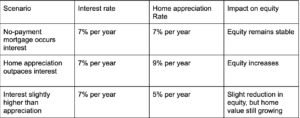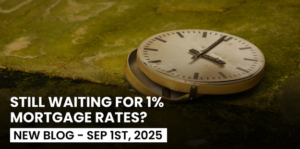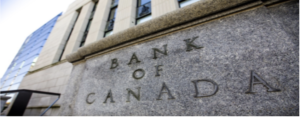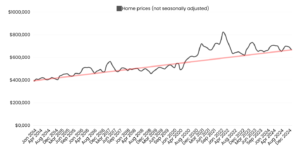Many homeowners think the only way to access their home equity is by selling or taking on a mortgage with monthly payments. But what if you could access funds without making a payment?
No-payment mortgage options—like reverse mortgages, alternative lender loans, and private mortgages—allow homeowners to borrow against their property without immediate repayment. Instead, interest is added to the loan balance and paid later when the home is sold or refinanced.

These solutions aren’t just for seniors. Homeowners of all ages have used no-payment mortgage options to:
- Build a new home – Private lenders often allow interest to accrue during construction.
- Take a mortgage break – Families may use these loans for a year off to travel, have a baby, or start a business.
- Cover short-term expenses – A temporary financial cushion without immediate repayment.
Whether you’re looking for long-term financial stability or a short-term funding solution, let’s explore how this type of mortgage might work for you.
Why Home Equity Growth Offsets Interest Costs
A common concern with no-payment mortgages is that interest accumulates over time, potentially reducing home equity. But what many don’t realize is that real estate values have historically increased at a rate similar to, or even higher than, mortgage interest rates

The key takeaway? If your home appreciates at the same rate as the interest accrues, the impact on your equity is minimal. In some cases, appreciation even outpaces borrowing costs, leaving you with more home equity despite taking out a loan.
A Real Example from a Canadian Homeowner
“I was hesitant about taking out a no-payment mortgage while I was building my new home, but it made a huge difference. It gave me the flexibility to finance construction without adding financial stress. By the time I was ready to refinance, my property had already appreciated, so I wasn’t losing equity at all.” – Michael S., 42, Calgary
Why Selling Too Early Can Be Costly
Many homeowners assume selling is the only way to free up equity, but that can come at a cost:
1. You Could Miss Out on Future Appreciation
If you sell too soon, you risk losing out on significant future home value growth. Many homeowners who sold 5–10 years ago now regret their decision, as property values have increased dramatically in most Canadian markets.
For example:
- The average Canadian home price has doubled since 2013.
- Even in slower markets, home prices tend to trend upward over time.
- If you wait just five more years, your home could appreciate significantly, adding tens or hundreds of thousands of dollars in value
2. You Might Be Giving Up an Asset for Your Kids
Many Canadian homeowners want to leave their house to their children, but selling early eliminates that possibility. A no-payment mortgage allows you to access home equity now while still holding onto the property.
3. Moving Too Soon Can Disrupt Your Lifestyle
Selling a home means:
- Relocating before it’s necessary
- Leaving a neighbourhood you love
- Paying real estate commissions and moving costs
A no-payment mortgage can help bridge financial gaps without forcing a move.
Long-Term Care: A Growing Concern for Seniors
For older Canadians, the rising cost of long-term care is a major financial worry:
- 70% of seniors will require some form of long-term care.
- The average cost of a private long-term care home is $3,000–$5,000 per month.
- In-home care services range from $20–$40 per hour, quickly adding up.
Many seniors sell their homes too soon to cover these expenses, when they could have stayed in their home longer by using a no-payment mortgage.
Example:
- A homeowner who took out a reverse mortgage in 2015 for $200,000 saw their home value increase by $300,000 over that period.
- The reverse mortgage allowed them to cover in-home care costs while still leaving a substantial asset for their family.

Who Can Benefit from a No-Payment Mortgage?
No-payment mortgages aren’t a one-size-fits-all solution, but they work well for many situations:
✔️ Seniors 55+ who want to stay in their home but need financial flexibility.
✔️ Homeowners building a home who need financing but want to delay payments.
✔️ New families who want a mortgage break while adjusting to parenthood.
✔️ Entrepreneurs who need financial breathing room to launch a business.
✔️ Anyone who can’t qualify for a HELOC or traditional mortgage due to income or credit.
FAQs About No-Payment Mortgages
Do I still own my home?
Yes! A no-payment mortgage doesn’t transfer ownership—you remain the homeowner, just like with any other mortgage.
What happens if home prices drop?
Most reverse mortgages and alternative lender loans come with a no-negative-equity guarantee, meaning you’ll never owe more than your home is worth. Lenders in Canada are conservative and don’t allow borrowing near the full home value.
Can I still leave my home to my children?
Yes. Since home values tend to increase over time, many homeowners still have equity left over after repaying the loan.
Is a reverse mortgage my only option?
No! If you qualify for a traditional mortgage or a HELOC, those can sometimes be cheaper alternatives. A no-payment mortgage is best for those who can’t qualify for traditional financing but still want to stay in their home or access their equity.
Can I use this for home renovations?
Absolutely. Many homeowners use no-payment mortgages to update their home, add accessibility features, or increase property value before selling.
What’s the difference between a reverse mortgage and a private lender loan?
- Reverse mortgages are for homeowners 55+ and offer a long-term solution with no payments.
Private lender loans can be used by any homeowner with enough equity, often for short-term financing like home construction or a temporary mortgage break.

How do I know if this is right for me?
Every situation is unique. If you’re considering a no-payment mortgage, I can walk you through your options side by side to help you make the best decision.





























